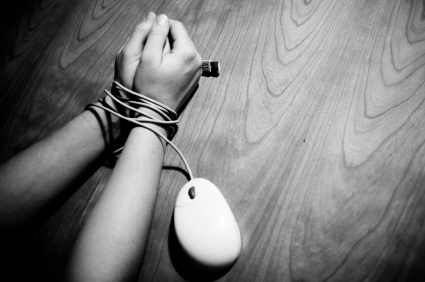Any type of behaviour or communication undertaken on the Internet and/or other technologies, such as text message, email, chatroom, youtube, facebook, instant messaging, etc., which have the purpose of hurting, harassing, shaming or scaring.![]()
One of the most common forms of online abuse is cyberbullying.
| What is cyberbullying? |
It is a form of bullying that takes place on the Internet and through new technologies, by which someone (normally a person or group you know in ‘real’ life) seeks to offend, shame and humiliate another person.
 |
Anyone can be a victim of cyberbullying through: |
- creation of fake profiles to humiliate and harm;
- emails or messages (via mobile phone, facebook, chats), shared with other people that contain false or humiliating information about someone;
- sharing / spreading emails or messages (via mobile phone, facebook, chats), containing private or inappropriate photos of someone, to embarrass and harm them (for example, photos or videos showing someone being attacked by a classmate or a group).![]()
Another form of online abuse is cyberstalking.
| What is cyberstalking? |
Stalking is a set of behaviors of continued and unwanted contacts inflicted by one person against another. The victim experiences these behaviours as unwelcome, intrusive and they trigger fear or concern.
CYBERSTLAKING is a form of stalking that involves the internet and new technologies to communicate and try to contact or approach someone else. ![]()
The stalker may be:
The stalker’s goal is to meet, seduce, harm or start an intimate relationship with someone (e.g., dating).
The stalking may initially seems harmless and even romantic:
- calling constantly to say 'hello' or to ask 'how are you?';
- sending several messages or emails with promises of love;
But those "harmless" contacts can turn into increasingly uncomfortable and real situations:
- showing up at the same places the other person usually goes to;
- following / watching the other person’s every step;
- it may even involve physical or verbal violence and threats.
![]()
Online abuse can cause many anxieties and fears:
-
the victim may not realise that what is happening is a form of violence;
-
the person may not know how to act to stop it happening;
-
the victim may not know who the perpetrator of the abuse is - whether it is a stranger or someone they know;
-
the offender may pretend to be someone else so their true identity is not revealed;
-
the victim may be afraid that the hurtful or humiliating communications will be shared with or sent to other people, particularly people they know.








